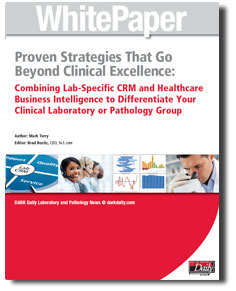CRM is a new product category for medical laboratory middleware and delivers real-time dashboards that drive higher levels of lab performance and client service
Within the clinical laboratory industry, there’s an interesting conjunction of two fast-moving trends. One trend is the growing use of middleware by medical laboratories of all sizes. The second trend is the goal of converting any type of manual work process in the lab into an automated work process.
These trends often intersect when clinical laboratories and pathology groups use middleware to automate manual processes. One common example is when a lab purchases a middleware solution that handles auto-validation. After implementation, auto-validation eliminates the need for medical technologists to manually review all the individual test results.
Clinical Laboratories Expanding Their Use of Middleware
One new direction for middleware is the rapid uptake by clinical labs of middleware solutions capable of automating management reporting. This is known as business intelligence (BI). A well-designed BI system provides the real-time flow of data that managers in well-run organizations use to reduce turnaround times, improve quality, and squeeze out unnecessary costs.
Moreover, the trends described above are finding favor for a simple reason: the steady decline in lab reimbursements and laboratory budgets is forcing cash-strapped lab managers to look for solutions that help them slash operating costs while improving the quality of clinical testing and levels of service they provide to referring physicians. One barrier to achieving these goals is the fact that labs—widely recognized to be data-rich environments—can’t get to this essential data.
To meet the demand by clinical laboratories for more sophisticated middleware and business intelligence, Brad Bostic CEO of hc1.com, developed a customer relationship management (CRM) system tailored specifically to the needs of medical laboratories and pathology groups. This lab CRM is an example of an emerging class of middleware solutions that provide clinical lab managers with real-time dashboards that allow them to automate manual management work processes and dramatically improve customer service levels. (Photo by hc1.com.)
Some experts would blame it on laboratory information systems (LIS) that are legacy systems built on information technology that dates as far back as the 1980s. (MUMPS, anyone?) That may be a bit unkind, in that the original design of an LIS was to support a different medical laboratory environment than exists today.
Further, the amazingly swift evolution of information technology has certainly outrun the capability of major health information technology companies to keep pace. In the world of consumer informatics, think about what was unleashed by Apple when it introduced the first iPod and the iTunes store in 2001. This was followed in 2007 by the iPhone, which revolutionized the cell phone industry. Next came the launch of the iPad in 2010. A host of smart phones and tablet computers now flood the marketplace and physicians are enthusiastically adopting these devices for medical purposes.
Information Technology Outrunning Ability of LIS Vendors to Keep Pace
That all happened in the space of just nine years! That pace of technology adoption has certainly outrun the ability of LIS vendors to incorporate next generation IT capabilities into the products they sell to their laboratory customers. And that brings us, once again, to why there is rising demand for middleware by clinical laboratories and pathology groups.
“Today’s clinical laboratory organization is rich in data, but this data does not improve client relationships unless integrated and presented in a way that allows laboratory staff to provide outstanding client service,” observed Brad Bostic, Founder, Chairman, and CEO of hc1.com, based in Indianapolis, Indiana.
Bostic pointed out that it can be weeks, or even months, from the time a lab manager requests a report from the IT department of the lab or hospital until that report is available. “The lag time and labor investment associated with this type of manual client reporting diminish the value of the information,” stated Bostic. “By contrast, a business intelligence service is designed to mine all the silos of data that exist within the lab organization and present that data in real time as actionable information tailored to the needs of each member of the lab staff.”
Medical Laboratories Have Interest in CRM Solutions
To access all this data, a growing number of clinical labs are purchasing and implementing customer relations management (CRM) systems. CRMs are designed to provide staff with tools and information necessary to interact effectively with current and prospective clients and deliver a consistent experience and customer satisfaction.
Until recently only generic CRM solutions were available. Thus, any lab purchasing a generic CRM system must invest additional money and time to customize the system. “Even with customization, generic CRMs are limited by their underlying data models,” pointed out Bostic. “A generic CRM might meet the needs of a company selling shoes or books, but the relationship management requirements of diagnostic laboratories are significantly more complex. A lab can try for years to customize a generic customer relationship management system, but its underlying data model will, at best, capture only about 10% of the total client picture.”
Lab CRM Used at South Bend Medical Foundation
Recognizing the need for a CRM designed specifically for use by clinical laboratories and pathology, the hc1.com healthcare CRM solution made its debut in the fall of 2011. One of the early users of this lab CRM and BI solution is the South Bend Medical Foundation (SBMF), the largest clinical laboratory organization serving South Bend, Indiana, and the surrounding region. (See The Dark Report: “Indiana Clinical Lab Taps Data to Improve Service to Doctors,” June 25, 2012.)
“For lab executives to truly benefit from a customer relationship management strategy, the CRM must understand both clinical data and operational data—along with the complex relationships between that data and the business activities of lab staff,” said Bostic. “Next, a lab-specific CRM should be capable of allowing the lab manager to identify trends in client service and client satisfaction in real time.
“Real-time dashboards should highlight important trends: automatically identifying any issues specific to a given provider; what caused the issue; and how any such issues were resolved,” explained Bostic. “This is a powerful strategy for all lab executives seeking to outperform the competition. It allows the lab’s sales team and customer service staff to have a full picture of the service any single client is receiving from the lab. Using this business intelligence in real time gives the lab a major competitive advantage at meeting and exceeding the service needs of client physicians.”
CRM Still a New Phenomenon for Nation’s Clinical Laboratories
Use of CRM systems is still a new phenomenon in the clinical lab industry. Dark Daily believes that Pathology Associates Medical Laboratories (PAML), of Spokane, Washington, was one of the first major lab organizations in the United States to implement a CRM back in the mid-2000s. It is a Microsoft CRM solution that was highly customized over the course of several years to meet PAML’s needs.
Further, as noted above, the hc1.com lab-specific CRM has been available for about 12 months and has a steadily growing number of lab users. Thus, while the middleware product category of a lab-specific CRM is still in its earliest stages, it is gaining rapid adoption. Current users are the first-mover and early-adopter lab organizations seeking differentiation with clients here in the United States.

To help clinical laboratory managers and pathologists understand more about the trends of business intelligence and automating manual management work processes, DarkDaily.com has published this special free White Paper. It can be immediately downloaded at darkdaily.com.
It is important for all clinical laboratory managers and pathologists who want to keep their lab organizations at the forefront of informatics to understand the forces driving the twin trends mentioned above. Middleware is becoming more sophisticated and the arrival of a lab CRM (LCRM) is consistent with how middleware can be tapped to deliver more value to a lab’s clients.
At the same time, the trend of automating manual work processes in the medical laboratory is also served by BI solutions, such as those included in a LCRM. Clinical lab executives will want to recognize that real-time dashboards are one way to automate middle manager activities that are currently done manually.
White Paper Available on Business Intelligence and Lab CRM
To provide more information on the trend of business intelligence and CRMs in the medical laboratory industry, the Dark Daily recently published a free White Paper on this topic. It is titled “Proven Strategies That Go Beyond Clinical Excellence: Combining Lab-Specific CRM and Healthcare Business Intelligence to Differentiate Your Clinical Laboratory or Pathology Group”, which can be immediately downloaded at darkdaily.com.
—By Patricia Kirk
Related Information:
The Dark Report: Indiana Clinical Lab Taps Data To Improve Service to Doctors
Indiana Clinical Lab Taps Data to Improve Service to Doctors
Business Intelligence Comes to The Clinical Laboratory Industry – Finally!
hc1.com Announces hc1 Apps; Features Breakthrough hc1 App from Chi Solutions
Five Questions for Brad Bostic, CEO of hc1.com
CRM Software that Even a Healthcare Professional can Love




